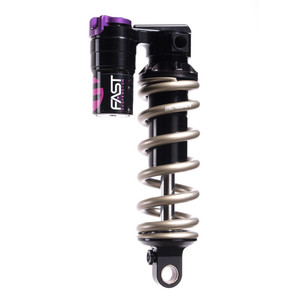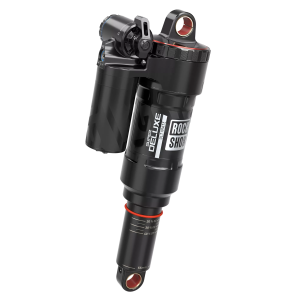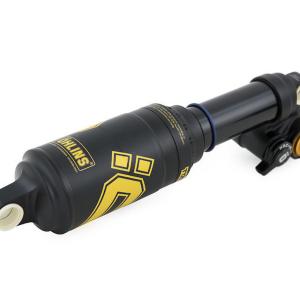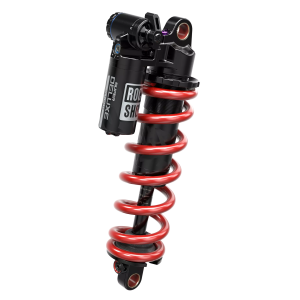Cane Creek DB Air CS Rear Shock
(discontinued)
| Where To Buy | |||
|---|---|---|---|
Free shipping on orders over $50 (continental U.S. only).
International shipping available. Some exclusions apply. |
|||
Free shipping on orders over $50 (continental U.S. only).
International shipping available. Some exclusions apply. |
|||
by Dave Trumpore
Cane Creek's highly rated Double Barrel Air shock recently received a new climbing assist feature dubbed the "Climb Switch" or CS for short. After hundreds of miles putting it through its paces, it’s time for us to weigh in on the addition.

2014 DBair CS Shock Highlights
- Weight: 509 grams (weight varies by size)
- Damping: Twin-tube independent compression and rebound in two high-speed and four low-speed damping circuits
- Adjustments: High speed compression, Low speed compression, High speed rebound, Low speed rebound, Air spring rate, Climb Switch on/off
- Shaft Material: Induction-hardened 4130 steel
- Shaft Diameter: 8mm
- Finish: Anodized and laser-etched
- Mounting Interface: Norglide bushing 1/2" Universal Axle
- Can Size: Standard (All Lengths) or Extra Volume (200, 215, 222, 240)
- Lengths:190 x 50mm (7.5” x 2.0”), 200 x 50mm (7.87” x 2.0”), 200 x 57mm (7.87 x 2.25”), 215 x 63mm (8.5” x 2.5”), 222 x 63mm (8.75” x 2.5”), 222 x 70mm (8.75” x 2.75”), 240 x 76mm (9.5” x 3.0”), 267 x 90mm (10.5” x 3.5”)
- MSRP: $695 USD
How Does It Work?
Twin Tube Technology circulates oil continuously through the damping valving to achieve highly controllable, independent damping for both compression and rebound strokes. This unique design moves oil through externally adjustable valving instead of the main piston.

CS is a selectable climbing mode on Double Barrel shocks that allows the rider to retain the advantages of a fully-suspended bike while climbing, without unwanted suspension motion. CS is not your conventional pedal-platform as it adjusts both low speed compression and low speed rebound at the same time.
The Climb Switch changes the low speed damping of Double Barrel shocks in one simple switch, to optimize suspension dynamics during climbing. It does this by activating a set of internal ‘climbing circuits’ that are accessed when CS is engaged. Cane Creek tunes these "climbing circuits" specifically for the demands of off-road climbing to achieve improved pedaling efficiently with less unwarranted chassis movement while retaining an active suspension platform.

Initial Impressions
Having already spent a day testing the DBair CS back in July, I had a fairly good idea of what I was getting my hands on, and the top notch craftsmanship of Cane Creek products really needs no elaborating - pulling one of these shocks out of the box is always a pleasure.
As with all Cane Creek shocks it shipped valved and tuned specifically for the intended bike, in this case my 2013 Giant Reign-X. Cane Creek attempts to take much of the initial setup hassle out of the picture for the end consumer by shipping each shock with a tuning guide and a base setting card that is specific to each individual frame. They claim that each shock is set to the proper base setting from the factory for you, so in theory all you need to do is bolt it on and ride with maybe only a small amount of adjustment to taste. Of course I checked to see if my shock was indeed set to the intended settings, which it turned out to be. Time to hit the trail.

On The Trail
I spent the first day riding the shock in the factory base setting as I wanted to see if Cane Creek had done their homework when creating tunes for each individual bike. Much like I found out in July during my initial test session, the base settings are very much spot on, and I would say 90% of the riders who buy this shock would be fully satisfied if they were to just leaving everything as is. However, I am a bit picky about suspension setup, and now that I had the shock mounted on my bike and riding my trails I was really able to dive in and see exactly how much more I could squeeze out of the settings.

First up, with the climb switch turned on my bike became a totally different animal and climbing took on a completely new sensation. There was no pedal bob, no feedback, no quirky platform feeling, and best of all no change in ride height/geometry since the CS does not affect sag. Probably the most striking attribute of this shock when in climb mode is that it retains its ability to absorb bumps with a controlled compression AND rebound stroke. Where most shocks in climb mode have a breakaway point you can sense and no rebound control, the DBair CS just hammers up the roughest climbs without you even knowing it's there. Hands down this is the best climbing shock I have ever ridden, and it does an amazing job of getting my 7-inch travel/30% sag trail bike up the thousand-foot extended climbs that are all too common here in Colorado.

Coming back down, it's hardly a surprise that the Twin Tube technology does an amazing job of controlling the ride. Cane Creek has built a solid reputation around providing shocks with superior damping and the DBAir CS is no different. I did end up settling on settings just a bit outside of the base settings provided, and I do tune the shock differently for trail riding and lift serviced bike park riding.

The adjustment range is pretty vast, but single turns or a few clicks do make a big difference. In the end I liked the shock with a bit slower low speed rebound, and firmer low speed compression. I would attribute this to the fact that I found the shock on my bike really comes alive in the 30% sag range, which on the Reign-X is quite soft; and I wanted to retain chassis stability and control.

In full-on DH terrain this shock shines, and there was very little terrain where I was able to push it past its ability. There was no fade and no change of damping characteristics even on the longest of descents. If anything the shock was so good that it brought out the flaws in the front suspension. Since both wheels need proper suspension to operate more as a system than individual components when talking overall ride characteristics, stability, grip and control, the fork ended up holding me back from really pushing the shock to its potential.

There were a few occasions where I forgot to flip the Climb Switch off at the top of a climb, only to remember part way down the descent as things started to feel a bit harsh in the rough. To be honest though, there were times I forgot and did not even notice as the shock still retains all of its function with CS on. I actually find myself riding in the CS mode quite often on the more mellow trails here as I don't always need the full travel my bike provides and it actually rides better in this setting when the going isn't so rough. I also find this setting extremely useful as a photographer when often times I find myself chasing the world's fastest racers around with a 30 pound camera pack on.
Things That Could Be Improved
First and foremost I would love to see tool free adjusters. Once I had the shock set this wasn't so much of an issue, but it is still a bother to me. Every other shock out there has tool free adjustment and it is something I have simply come to expect. I would even settle for a "tool" that snaps into one of the adjusters similar to the rebound adjuster on many forks. That way I wouldn't have to break out my allen set, nor would the shock have to gain the weight and complexity of adding 4 adjustment dials.

I would also like to be able to measure sag and overall use of travel a bit easier. A graphic on the shock shaft combined with a rubber o-ring makes that part of setting up so much easier. Trying to sit on a bike to gauge sag without this is a huge pain, especially since only a few millimeters change in sag one way or the other makes a huge difference. It is also next to impossible to gauge how much travel the shock is/isn't using through different sections without a rubber o-ring, which I find quite useful when evaluating how a shock is performing. In the end I put my own o-ring on there, but for $695 I would like to see one tossed in with the owners manual.
I didn't have this issue, but I must mention that the small Climb Switch could be difficult to reach on some frames. Even on a frame where the shock is fairly centrally located, it was still quite a reach with the seat all the way up. On a bike with a very low shock position it could be an issue.

And of course then there's the price. Yes, the performance is amazing, but the cost of high end bicycle components is a bit out of hand these days. The DBair CS does make my bike far more enjoyable to ride, but I'm not sure I would trade that for something else that $695 could buy me.
Long Term Durability
I have had this shock for 4 months and ridden and raced it all over Colorado, from the Enduro World Series to Fruita and everywhere in between. I have had zero issues. The CS lever stayed tight (unlike some other shocks out there) so I never had to worry about the climb adjustment switching itself on or off in rough terrain. I also found that it holds air longer than my previous air shocks which is an added bonus.
What’s The Bottom Line?
Without a doubt I can say this shock is on par with the best out there, and a definite upgrade to any bike. On many modern 5 to 7-inch trail bikes it is hard or impossible to climb efficiently without some kind of climbing assist function, and the DBair CS provides this better than anything I have ever ridden. You get all the benefits of a climb setting without any of the drawbacks. I will say that if you are going to drop $695 on this shock and you are still riding an older and/or mid-range fork, you might want to consider an upgrade to the front end as well to really take advantage of how good the DBair's damping is.
Setup is a breeze, so don't be scared away by all those adjustments. Cane Creek has done their homework, and while this appears to be the most complex shock on the market, it is one of the only shocks that practically comes set up and custom tuned out of the box.
For more information, check out www.canecreek.com.
About The Reviewer
Dave Trumpore’s 20-year riding career has seen him sling a leg over the best and the worst the mountain bike industry has produced during that time. From Junior Expert XC in his early racing days to Pro DH from 1998-2009, a handful of World Cup finals take pride of place on Dave’s resume. Not being the biggest guy out there he has a smooth style focused on carrying speed rather than smashing his way down the trail. He has always taken a very technical approach to bike setup, in particular with suspension and brakes. After trading number plates for a camera, Dave can now be found chasing the fastest riders on the planet when he’s not out racking up thousands of feet climbing and descending while exploring the vast high alpine trail networks of the Rocky Mountains.
2 member reviews
Purchased the Double Barrel Air CS to replace the 2014 Float Evolution that came stock on my Carbon Nomad.
Currently unknown tuning as I set the DBA accordingly to the SC Nomad settings found on their site and made my own adjustments as I rode. With that said, it feels, dare I say it, perfect. No volume spacers, but has the XV air can installed.
Tested on a '14 SC Carbon Nomad with both the '14 Float CTD FIT and '14 Pike.
Right after mounting it on the Nomad, there was definitely some out-of-the-box stiction, but smoothed out after a few tunes+rides. The factory tune definitely felt weird on the VPP Nomad so there was quite a bit of work to be done in terms of tuning. With the stock tune, the Float felt better. After adjusting to the Nomad tune on the Cane Creek website, it was quite surprising to see how much the DBA can change with an allen key. It went from feeling like a blown up coil shock to 85% perfect. Once I tried it on the driveway, I immediately went for a trail rip. Already, I can feel that it's leagues ahead of the Float.
However, it didn't feel perfect still. A late disclaimer here, but I do not recommend the DBA to people who dislike adjustments and with little/no patience. Tuning the DBA was an interesting experience for me as I never thought I can get so angry at a working shock. I admit, I'm a light perfectionist.
After half a month of riding and performing micro adjustments, I finally got it to a setting where it felt "perfect" for the trails I'm riding and this is where I went full-on. Much like the Pike up front, the DBA soaks up everything I throw at it, be it rock gardens, jumps, cased jumps, boulders, drops, and etc.
The DBA is a difficult shock to review as you can literally adjust it to your liking, so most of the time people will be satisfied with its performance. Even if I were to say that the DBA would be nice with a more progressive curve, you can add volume spacers or get the XV volume can to further adjust the DBA. The adjustments seem endless.
I literally can't think of a negative aspect with this shock. The only things I can nitpick at is how tuning the shock can be a challenge and the above average price tag. Others may nitpick at how the Air doesn't feel like the Coil, but in all honesty, the DBA feels very much like a Coil shock. It's been super reliable and seems to hold its air for a long time.
Definitely worth every extra penny.
0 comments
Post a reply to: Contender for the BEST air shock? (once you set it up)
I've had two of these shocks. Both were on my Banshee Rune. Once it's set up its awesome but it doesn't stay awesome for long. After 4 - 6 months of use I experienced air can issues in both shocks. I've lost air completely or would lose around 20 - 30 pounds per ride. Service was expensive with long turn around times.
When working however this shock is awesome. Understand though that there is a lot of set up. I recommend talking to your frame manufacturer and ask them about base settings otherwise you could be lost. Generally I think there are too many clicks, does anyone really use the extremes on any of the dials? Most of us will be somewhere far from it.
I'm also not so sure about the climb switch. It doesn't really provide much of a platform. I really just used it on flowy trails. I replaced my CCDBAcs with an X2 2 pos and have not looked back.
0 comments
Post a reply to: Awesome when you get it set up then... well its a roll of the di
Specifications
185mm x 52.5mm
185mm x 55mm
190mm x 50mm
200mm x 50mm
200mm x 57mm
205mm x 57.5mm
205mm x 60mm
205mm x 62.5mm
205mm x 65mm
210mm x 50mm
210mm x 52.5mm
210mm x 55mm
216mm x 57mm
216mm x 63mm
222mm x 63mm
222mm x 70mm
225mm x 70mm
225mm x 75mm
230mm x 57.5mm
230mm x 60mm
230mm x 65mm
240mm x 76mm
250mm x 70mm
250mm x 75mm
Double Barrel (DB) Twin-tube independent compression and rebound in two high-speed and four low-speed damping circuits
Auto-adjust negative air spring
Air volume adjustable via spacers
Higher-volume XV air can available (200mm, 216mm, 222mm, and 240mm only)
Anodized and laser etched finish
Norglide bushing 1/2" universal axle mounting interface
| Where To Buy | |||
|---|---|---|---|
Free shipping on orders over $50 (continental U.S. only).
International shipping available. Some exclusions apply. |
|||
Free shipping on orders over $50 (continental U.S. only).
International shipping available. Some exclusions apply. |
|||






























9 comments
Post a reply to: Tested: 2014 Cane Creek DBair CS Rear Shock